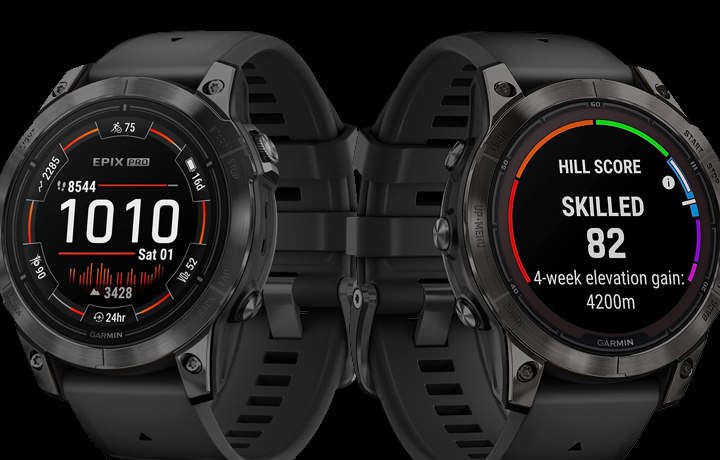Sunlight or AMOLED: Which Display Shines Brighter?
Regarding visibility and readability, the Fenix 7 Pro‘s memory and pixel display performs exceptionally well outdoors. This display technology is optimized for outdoor use and usually doesn’t require the backlight in daylight unless the surroundings are extremely dark.
Meanwhile, the Epix Pro remains visible in bright conditions by increasing the display’s brightness. However, the Fenix 7 Pro’s transflective display is generally more readable outdoors. Indoors, the differences in performance between the two displays are less pronounced.
So, in a well-lit room during the day or with the lights on, both displays perform well for a quick glance. Of course, this assumes that the always-on display is enabled on the FX Pro. However, in darker conditions, there are some notable differences.
One advantage of the memory pixel display on the Fenix 7 Pro at night is that it doesn’t emit any light. Personally, I find this less distracting than an AMOLED display with the always-on mode enabled. For instance, in a dark movie theater, a subtle amount of light is desirable.
However, the Epix Pro offers an additional option in the controls menu to completely turn off the display and override the always-on mode. On the flip side, in extremely dark conditions, the memory pixel display on the Fenix 7 Pro becomes invisible, whereas the Epix Pro’s always-on mode remains dimly visible.
To make the Fenix 7 Pro’s display visible in such darkness, the backlight needs to be enabled. Unfortunately, the backlight illuminates the entire display, so even with a predominantly dark background, some light is noticeable behind the black portions.
In contrast, with an AMOLED display, even in darkness, the always-on mode with dimmed brightness may still be visible without fully waking up the display to maximum brightness.
The memory pixel display on the Fenix 7 Pro has an upgraded backlight that offers a wider range of brightness levels, including dimmer settings. This feature helps reduce blue light at night. Both watches have a sleep mode, but the way they function differs due to their display technology.
The Epix Pro gradually dims the display to its lowest level and then turns it off completely after some inactivity. On the other hand, the Fenix 7 Pro’s memory pixel display, which doesn’t emit any light, continues to show the time on the display after a period of inactivity.
However, in a completely dark room, the backlight needs to be turned on to see the time. Additionally, the Epix Pro offers a redshift mode during sleep mode, which turns the entire display red, claimed to be easier on the eyes and prevent sleep cycle interruptions.
Lighting Conditions:
The Fenix 7 Pro introduces a new auto-brightness setting that adjusts the brightness based on ambient lighting conditions. Interestingly, it utilizes the solar panel as the ambient light sensor.
While I initially had mixed feelings about this feature, finding it dull in most situations, it has gradually grown on me. I’m not sure if I’ve become more accustomed to it or if there have been adjustments to its behavior.
While the Fenix 7 Pro excels in outdoor readability and overall battery life, it’s hard to deny the stunning appearance of the Epix Pro’s display. With deep, saturated colors, high contrast, and a higher resolution, it noticeably enhances the entire interface.
Despite sharing the same interface design, the display on the Epix Pro resembles that of a smartphone, with vibrant colors, deep blacks, bright whites, and a smoother interface appearance. However, the Fenix 7 Pro’s display is still satisfactory and doesn’t resemble a calculator or anything of the sort. Nevertheless, the Epix Pro’s higher pixel density allows for more detailed content.
The increased resolution on the Epix Pro makes a significant difference when it comes to maps. Comparing the included topo maps on both watches, the Fenix 7 Pro provides good information and context but lacks the level of detail present on the Epix Pro. The shaded relief map overlay and weather map overlays also exhibit more definition and visual appeal on the Epix Pro’s display.
One notable observation is that the Fenix 7 Pro redraws maps slightly faster, likely due to its lower pixel count requiring less processing power. The display differences regarding resolution and color saturation also extend to the watch faces.
While the Epix Pro offers a few more watch faces than the Fenix 7 Pro, the design of these faces takes full advantage of the higher pixel density. As you can see in the list, some faces share a similar design theme but differ in detail. The following list showcases the available watch faces for both watches, allowing you to get an idea of their offerings. Additionally, the Epix Pro provides a few additional watch faces not found on the Fenix 7 Pro. Read more..
Check out the latest price of the Garmin Epix Pro Here, or Garmin Fenix 7 Pro Here.







